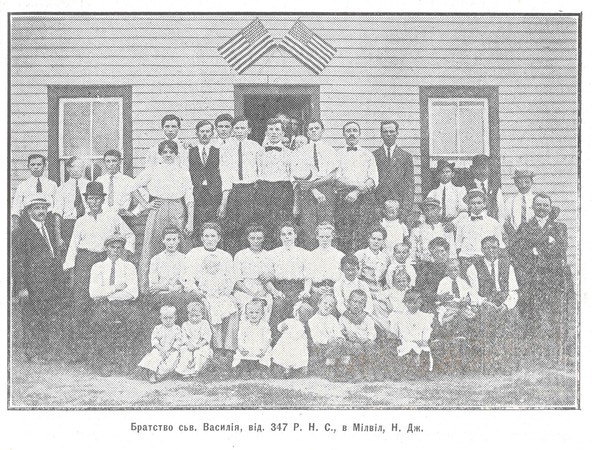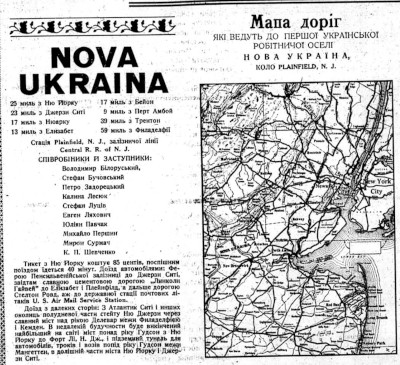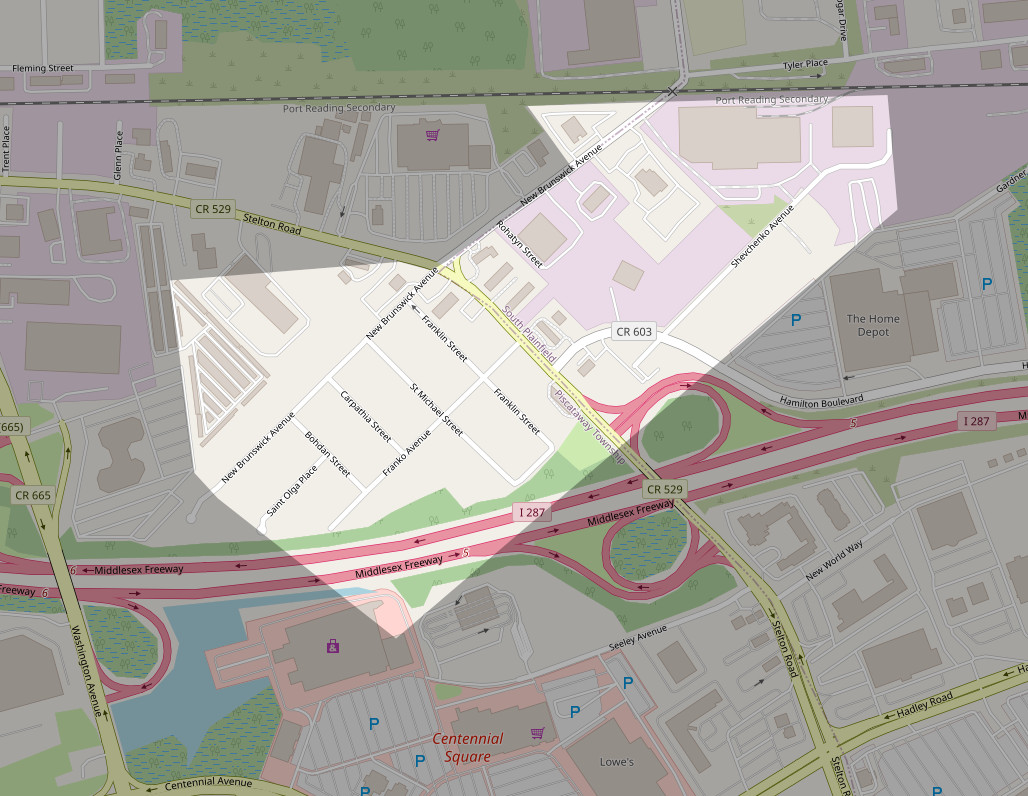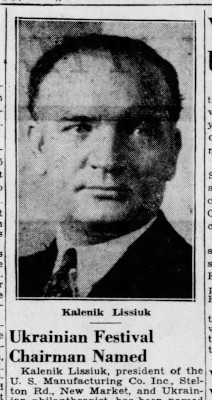In the early part of the twentieth century, most Ruthenian-Ukrainians settled in urban and mining areas where jobs were plentiful. Some, however, were farmers. In 1896-98, Ukrainian Baptists (“Stundists”) from eastern Ukraine became farmers in North Dakota after a short stay in Virginia. They were joined by Galician-Ruthenians.Kuropas, Myron B. The Ukrainian Americans: Roots and Aspirations 1884-1954. Toronto, Canada: University of Toronto Press, 1991. pp. 37-38. There were also farming communities in New York, Indiana, Michigan, Wisconsin, Texas and Oklahoma. And rural New Jersey had its own farming communities where Ukrainians settled.
Great Meadows (Independence Township, Warren County)
The oldest rural settlement in the state grew up in the area around Great Meadows (originally called “Danville”). Great Meadows is an unincorporated community located within Independence Township in Warren County. It is well known for its truck farms, and, especially, for growing celery and onion crops. The soil is unique in the area and is composed of a rich, fertile black soil known locally as “black muck”.
In 1906, the brothers Roman and Ivan Kovalik arrived here from Radekhov (Radekhiv) Galicia (now in Lviv Oblast, Ukraine) and became local wage workers.Jubilee Book of the Ukrainian National Association, 1936, p. 599. Soon others from their village followed, as well as from Zalishchyky (now in Ternopil Oblast, Ukraine). The immigrants worked hard, saved their money, and eventually bought out some of the local farmers for whom they worked to acquire land of their own. The size of their farms ranged from 25 to 600 acres. They were joined by other Ukrainian immigrants who came via the Ukrainian community in Elizabeth, N.J. The Ukrainian community grew so much that by 1934 almost all the children at the Alafeno school were of either of Ukrainian or Polish descent.Halich, Wasyl. Ukrainians in the United States. p. 49.
A search of the 1930 Federal Census on Ancestry.com shows there were 88 residents of Independence Township (where Great Meadows is located) whose primary language was Ukrainian, out of a total population of 964. The oldest Ukrainian immigrant resident was Michael Sedlar (age 65), who arrived in the U.S. in 1886. The number of residents whose primary language was Polish in the same period was 59. By 1936, there was a total of 80 Ukrainian families in the area.Jubilee Book of the Ukrainian National Association, 1936, p. 599.
The Ukrainian community of Great Meadows was able to complete the building of St. Nicholas Ukrainian Catholic Church in the spring of 1923 after a few years of planning, and it still stands today. Land for the church was donated for the church by Andrew and Mamie Nykun and ground was broken and the cornerstone laid in 1922. It was not until July 1936 that a parish hall was built on Route 46. The parish did not have a full-time resident pastor until 1949, when Rev. Marko Gill arrived. He would serve the parish until his death in 1965.
Millville (Cumberland County)
When Ruthenians first arrived in the Millville (Vineland-Bridgeton) area in 1910, it was rural and agricultural. The Vineland area became well known for grape-growing in the late 19th and early 20th centuries through the efforts of Charles K. Landis, a major landowner. He advertised to Italians to encourage them to purchase land for grape-growing. The sandy soil was also a major draw for the glass-making industry, with Wheaton Industries being a major manufacturer of glassware and ceramics in Millville. Poultry farming was also a major contributor to the local economy.Spahr, Rob. “Vineland celebrates its 150th anniversary with parade, fireworks and cake”, The Press of Atlantic City, August 8, 2011.
Newcomers from Galicia

‘European Colonization Company’ advertisement for ‘the first Ruthenian colony’ in Millville, NJ (Svoboda, 1914-04-16)
Ukrainians came from the counties of Bibrka, Rohatyn, Borshchiv, Skalat, Syanik and Kolomyia in Galicia.Jubilee Book of the Ukrainian National Association, 1936, p. 607. In 1912, a Ukrainian real estate agent named Wasyl Metolych started to advertise land for sale near Millville in the newspaper Svoboda. This enticed about 200 families to build homes, farm buildings, two churches, and schools there. Even Ukrainians who had initially settled in North Dakota sold their farms and moved to Millville. However, the sandy nature of the local soil made it difficult to produce crops early on and many became disenchanted, suggesting they had become victims of false advertising in Svoboda. Sixteen men held a meeting at the home of N. Hevchuk on April 5, 1914 and adopted a complaint resolution which they later printed in the Narodna Volya newspaper (published in Scranton, Pa.).Halich, Wasyl. Ukrainians in the United States. p. 49, 58.

Brotherhood of St. Basil, branch 347 of the ‘Rus’kyi Narodnyi Soiuz’ (‘Little Russian National Union’) in Millville, N. J.
Time passed and many decided to keep their 10-acre farms, successfully cultivating crops for truck farming. New Ukrainian immigrants arrived and eventually there were 211 people who indicated “Ukrainian” as their primary language in the 1930 Federal Census. In addition to farming, some Ukrainian immigrants worked in glassmaking and at a cotton factory.
Two churches were built: Sts Peter and Paul Ukrainian Orthodox (1917) and St. Nicholas Ukrainian Catholic Church (first built in 1918, replaced with a new building in 1939). There were a few Ukrainian business enterprises in the area, such as a grocery and meat market, a transportation business, and a bread distributor.
The long journey of Theodore Dupnock
Theodore Dupnock (born 1866) was a long-time resident of the Millville community. He served in the Austro-Hungarian army before emigrating to the U.S from Polany in the Dukla area of Galicia. After arriving at Ellis Island in 1887, Mr. Dupnock went to Shamokin, Pa., where he became a miner for the Susquehanna Coal Company. He was a founder of the local Transfiguration Ukrainian Catholic Church there. By 1912, at age 46, he began to develop black lung disease and decided to change where he lived and worked.
The European Colonization Company located at 19-20 North Hight St. (headquartered in Philadelphia, Pa.) began a campaign to attract miners from Pennsylvania Coal Country to Millville. Mr. Dupnock bought 33 acres at a cost of $250 an acre along Carmel Rd. in 1912. He found work in the Whitall Tatum Company, one of the first glass factories in the U.S. In 1918 he donated a piece of property from his farm for the building of St. Nicholas Ukrainian Catholic Church.The Millville Daily, Millville, N.J. July 6, 1965, p. 2.
Theodore and his wife Anna would have a family of twelve children. Their son John, said that his mother (who came from a Ukrainian neighborhood in Elizabeth, N.J.) had a very demanding life on the farm making butter for local merchants and selling eggs and cheese. Her income from this activity was essential to keep the family going. John was born during the Great Depression and he said many Ukrainian children in the area had to go to work to help support their families at the time.The Millville Daily, Millville, N.J. November 10, 1982. p.1 and p. 10 Theodore Dupnock passed away in 1965, leaving a legacy of hard work and a great appreciation of Ukrainian culture to his children and grandchildren.
Nova Ukraina in New Market (Piscataway, Middlesex County)
As the Ukrainian population of Middlesex County expanded and looked for more suburban and rural places to raise a family, a new Ukrainian real estate development was formed in the New Market section of Piscataway in 1927. New Market is an unincorporated community in Middlesex County near South Plainfield. In colonial times, New Market was a stop on the stagecoach route (Old York Road) from Philadelphia to New York City. It remained mostly farmland until the 1960s.
A new Ukrainian real estate development

Advertisement for property in the Nova Ukraina real estate development
In March of 1927, a large advertisement appeared in the Svoboda Newspaper. The Globe Service Company located on E. 7th St. in the Ukrainian section of the Lower East Side of Manhattan described a new real estate “settlement for Ukrainians who work in factories”. The ad went on to describe how bad it was to live in “the big city” and the advantages of fresh air and sunlight. There was also a patriotic appeal suggesting it would be easier for Ukrainians to maintain their traditions and culture together in their own neighborhood. The street names would be registered to honor famous Ukrainians, such as the writers Taras Shevchenko and Ivan Franko, the composer Mykola Lysenko, the medieval ruler St. Olga, and other Ukrainian-themed names. Showing of the property would begin in April. It was located on Stelton Rd. north of the Hadley Field airport (known for being the site of some of the first U.S. Postal Service airmail flights).
As a period map made for the Globe Service Company by the local surveying and engineering firm F. A. Dunham shows, the project was extremely ambitious. It would have included hundreds of residential parcels on either side of Stelton Rd., extending to the north to the Port Reading Secondary railroad. The extent of the development can be seen by overlaying the outline of the property purchased by the Globe Service Company onto the current street map as of 2024.



Photograph of Kalenik Lissiuk published in the Courier-News (Bridgewater, New Jersey), 1946-03-06
“Collaborators and representatives” for this development included Myron Surmach, the founder of the venerable Surma Book & Music Co. of New York City, and Kalenik Lissiuk (born Hryhorii Lepikash), a Ukrainian entrepreneur who by 1929 was the director of the enterprise. Lissiuk had quite a colorful personal history and was born in the Russian Empire part of Ukraine in 1889. As a young man, he was an active Socialist Revolutionary, spent time in Siberia after being arrested, and fought in the Army of the Ukrainian People’s Republic in Ukraine’s war of independence (1917-1921) and was one of the organizers of the Free Cossack movement. He eventually came to the U.S. and started a stamp and sundries store in New York City in 1923. After taking over the directorship of Nova Ukraina, Lysiuk moved there in 1931.
Slow growth of the community
Despite active efforts to promote the community, Nova Ukraina grew very slowly, quite possibly due to the effects of the Great Depression. A 1936 local newspaper article said plans were in place to build 50 “moderately priced” homes at about $2,450 each. Advantages of living there included a backyard chicken coop for raising poultry and a truck that brought coal directly from the anthracite region of Pennsylvania. Overall, there were 120 acres in the tract, including woodlands. Stephan Dembitsky, manager of the Metropolitan Life Insurance Company in Perth Amboy, had a house under construction there in 1936.The Sunday Times. New Brunswick, N.J. March 8, 1936, p. 24.
By 1942, Nova Ukraina had only a dozen Ukrainian, Polish and Russian families.The Sunday Times. New Brunswick, N.J., August 2, 1942, p. 2. However, the Piscataway area had at least 48 people who considered their first language as Ukrainian, according to the 1930 Federal Census, and nearby South Plainfield had 151 families, with 20 from Dnipro Oblast in Eastern Ukraine and the rest from Western Ukraine. By 1950, Kalenik Lissiuk would leave Nova Ukraina for Ontario, California, where he would establish a Ukrainian museum (which later merged with the Ukrainian National Museum of Chicago) and a philanthropy called The Ukrainian-American Foundation. He continued to play an active role in the Ukrainian American community and politics until his death in 1980.
There are likely no Ukrainians living today in the former Nova Ukraina of Piscataway and South Plainfield. What had been a housing development surrounded by open countryside is now a tiny residential island in the congested retail and commercial area near Exit 5 of Interstate 287. Nonetheless, some of the original street names remain, including Shevchenko Ave., St. Olga Pl., Bohdan St., Carpathia St, Franko Ave., and St. Michael St. There is even a playground that shows up on Google Maps as “Nova Ukraine Park”.
